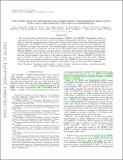| dc.contributor.author | Albrecht, Simon H. | |
| dc.contributor.author | Winn, Joshua Nathan | |
| dc.contributor.author | Johnson, John Asher | |
| dc.contributor.author | Butler, R. Paul | |
| dc.contributor.author | Crane, Jeffrey D. | |
| dc.contributor.author | Shectman, Stephen A. | |
| dc.contributor.author | Thompson, Ian B. | |
| dc.contributor.author | Narita, Norio | |
| dc.contributor.author | Sato, Bun'ei | |
| dc.contributor.author | Hirano, Teruyuki | |
| dc.contributor.author | Enya, Keigo | |
| dc.contributor.author | Fischer, Debra A. | |
| dc.date.accessioned | 2012-08-22T16:10:21Z | |
| dc.date.available | 2012-08-22T16:10:21Z | |
| dc.date.issued | 2011-09 | |
| dc.date.submitted | 2011-05 | |
| dc.identifier.issn | 0004-637X | |
| dc.identifier.issn | 1538-4357 | |
| dc.identifier.uri | http://hdl.handle.net/1721.1/72323 | |
| dc.description.abstract | We present precise radial-velocity (RV) measurements of WASP-1 and WASP-2 throughout transits of their giant planets. Our goal was to detect the Rossiter-McLaughlin (RM) effect, the anomalous RV observed during eclipses of rotating stars, which can be used to study the obliquities of planet-hosting stars. For WASP-1, a weak signal of a prograde orbit was detected with [almost equal to]2omega confidence, and for WASP-2 no signal was detected. The resulting upper bounds on the RM amplitude have different implications for these two systems because of the contrasting transit geometries and the stellar types. Because WASP-1 is an F7V star, and such stars are typically rapid rotators, the most probable reason for the suppression of the RM effect is that the star is viewed nearly pole-on. This implies that the WASP-1 star has a high obliquity with respect to the edge-on planetary orbit. Because WASP-2 is a K1V star, and is expected to be a slow rotator, no firm conclusion can be drawn about the stellar obliquity. Our data and our analysis contradict an earlier claim that WASP-2b has a retrograde orbit, thereby revoking this system's status as an exception to the pattern that cool stars have low obliquities. | en_US |
| dc.description.sponsorship | Netherlands Organization for Scientific Research ((NWO) Rubicon Fellowship) | en_US |
| dc.description.sponsorship | United States. National Aeronautics and Space Administration (NASA Origins grant NNX09AD36G) | en_US |
| dc.language.iso | en_US | |
| dc.publisher | Institute of Physics Publishing | en_US |
| dc.relation.isversionof | http://dx.doi.org/10.1088/0004-637x/738/1/50 | en_US |
| dc.rights | Creative Commons Attribution-Noncommercial-Share Alike 3.0 | en_US |
| dc.rights.uri | http://creativecommons.org/licenses/by-nc-sa/3.0/ | en_US |
| dc.source | Prof. Winn via Mat Willmott | en_US |
| dc.title | TWO UPPER LIMITS ON THE ROSSITER-MCLAUGHLIN EFFECT, WITH DIFFERING IMPLICATIONS: WASP-1 HAS A HIGH OBLIQUITY AND WASP-2 IS INDETERMINATE | en_US |
| dc.type | Article | en_US |
| dc.identifier.citation | Albrecht, Simon et al. “TWO UPPER LIMITS ON THE ROSSITER-MCLAUGHLIN EFFECT, WITH DIFFERING IMPLICATIONS: WASP-1 HAS A HIGH OBLIQUITY AND WASP-2 IS INDETERMINATE.” The Astrophysical Journal 738.1 (2011): 50. Web. | en_US |
| dc.contributor.department | Massachusetts Institute of Technology. Department of Physics | en_US |
| dc.contributor.department | MIT Kavli Institute for Astrophysics and Space Research | en_US |
| dc.contributor.approver | Winn, Joshua Nathan | |
| dc.contributor.mitauthor | Winn, Joshua Nathan | |
| dc.contributor.mitauthor | Albrecht, Simon H. | |
| dc.relation.journal | Astrophysical Journal | en_US |
| dc.eprint.version | Author's final manuscript | en_US |
| dc.type.uri | http://purl.org/eprint/type/JournalArticle | en_US |
| eprint.status | http://purl.org/eprint/status/PeerReviewed | en_US |
| dspace.orderedauthors | Albrecht, Simon; Winn, Joshua N.; Johnson, John Asher; Paul Butler, R.; Crane, Jeffrey D.; Shectman, Stephen A.; Thompson, Ian B.; Narita, Norio; Sato, Bun'ei; Hirano, Teruyuki; Enya, Keigo; Fischer, Debra | en |
| dc.identifier.orcid | https://orcid.org/0000-0002-4265-047X | |
| mit.license | OPEN_ACCESS_POLICY | en_US |
| mit.metadata.status | Complete | |
